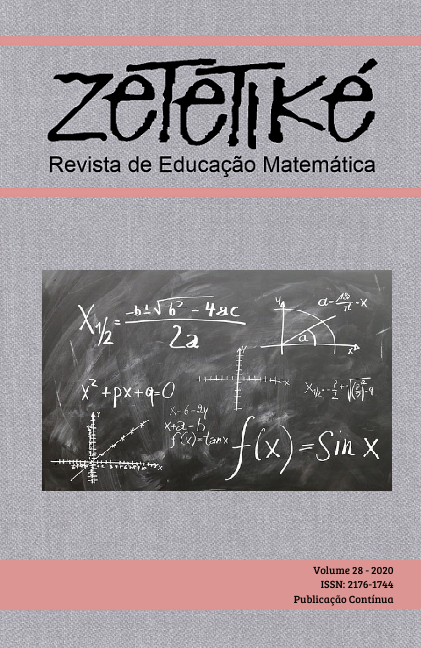Abstract
While evidence shows number estimation and working memory are important factors in math achievement, little is known about the relationship between number estimation and working memory. Therefore, the aim of this study is to investigate the relationships between number estimation, working memory and quantitative reasoning. To do so, 143 3rd and 4th graders from two public schools in Porto Alegre/RS were assessed. The results reveal significant relationships between the three measures, with the highest levels of correlation being between quantitative reasoning and number line estimation and between the central executive and episodic buffer, which are components of the working memory, and additive reasoning. The results suggest a direct association between ability in number line estimation, working memory and math skills in quantitative reasoning.
References
Angelini, A., Alves, I., Custódio, E., Duarte, W., & Duarte, J. (1999). Matrizes Progressivas Coloridas de Raven: Escala Especial. Manual. São Paulo, SP: CETEPP
Andersson, U. (2008). Working memory as a predictor of written arithmetical skills in children: The importance of central executive functions. British Journal of Educational Psychology, 78(2), 181–203.
Andersson, U., & Lyxell, B. (2007). Working memory deficit in children with mathematical difficulties: A general or specific deficit? Journal of Experimental Child Psychology, 96(3), 197–228.
Ashcraft, M. H., & Moore, A. M. (2012). Cognitive processes of numerical estimation in children. Journal of Experimental Child Psychology, 111(2), 246–267.
Baddeley, A. (2000). The episodic buffer: A new component of working memory? Trends in Cognitive Sciences, 4(11), 417–423.
Baddeley, A. (2011). Memória de Trabalho. In A. Baddeley, M. C. Anderson, & M. W. Eysenck (Eds.), Memória. Porto Alegre: Artmed.
Booth, J. L., & Siegler, R. S. (2006). Developmental and individual differences in pure numerical estimation. Developmental Psychology, 42(1), 189–201.
Booth, J. L., & Siegler, R. S. (2008). Numerical magnitude representations influence arithmetic learning. Child Development, 79(4), 1016–1031.
Corso, L. V. (2008). Dificuldades na leitura e na matemática: um estudo dos processos cognitivos em alunos da 3a a 6a série do Ensino Fundamental (Tese de Doutorado). Programa de Pós-Graduação em Educação. Universidade Federal do Rio Grande do Sul. Faculdade de Educação, Porto Alegre.
Corso, L. V., & Dorneles, B. V. (2012). Qual o papel que a memória de trabalho exerce na aprendizagem da matemática ? What role does the working memory play in mathematics learning ? Bolema, 26(42B), 627–647.
Dehaene, S. (1997). The number sense: How the mind creates mathematics (1st ed.). New York.
Gathercole, S. E., & Alloway, T. P. (2004). Working memory and classroom learning. Dyslexia Review, 17, 1–41.
Laski, E. V., & Siegler, R. S. (2007). Is 27 a big number? Correlational and causal connections among numerical categorization, number line estimation, and numerical magnitude comparison. Child Development, 78(6), 1723–1743.
Lee, K., & Bull, R. (2016) Developmental changes in working memory, updating, and math achievement. Journal of Educational Psychology, v. 108, n. 6, p. 869-882.
Leung, D. C. M. (2011). The contribution of working memory resources to arithmetic performance. 2011. 228 f. Thesis (Doctor’s Degree of Philosophy) – University of Western Australia, School of Psychology.
Link, T., Nuerk, H. C., & Moeller, K. (2014). On the relation between the mental number line and arithmetic competencies. Quarterly Journal of Experimental Psychology, 67(8), 1597–1613.
Malloy-Diniz, L. F., Fuentes, D., Abrantes, S. S., Lasmar, V. A., & Salgado, J. V. (2010) Teste de aprendizagem auditivo-verbal de Rey (RAVLT). In L. F. Malloy-Diniz; D. Fuentes, O. Mattos; N. Abreu, Avaliação neuropsicológica. Porto Alegre: Artmed.
Martins, F. C., & Ortiz, K. Z. (2009). The relationship between working memory and apraxia of speech. Arq Neuropsiquiatr., 3B(67), 843-848.
Meyer, M. L., Salimpoor, V. N., Wu, S. S., Geary, D. C., & Menon, V. (2010). Differential contribution of specific working memory components to mathematics achievement in 2nd and 3rd graders. Learning and Individual Differences, 20(2), 101–109.
Ministério da Educação. (MEC). (1997). Secretaria de Educação Fundamental. Parâmetros curriculares nacionais: matemática / Secretaria de Educação Fundamental. – Brasília : MEC/SEF.
Moore, A. M., & Ashcraft, M. H. (2015). Children’s mathematical performance: Five cognitive tasks across five grades. Journal of Experimental Child Psychology, 135, 1–24.
Nobre, A. T., Rodrigues, J. C., Sbicigo, J. B., Piccolo, L. R., Zortea, M., Duarte Jr., S., & Salles, J. F. de. (2013). Tasks for assessment of the episodic buffer: a systematic review. Psychology & Neuroscience, 3(6), 331-343.
Nunes, T. (2009). Teacher notes. Retirado em 15 de março, 2019, de: <http://www.education.ox.ac.uk/ndcs/Resources/teachersbook_exercises.pdf>.
Nunes, T., Campos, T. M. M., Magina, S., & Bryant, P. (2005). Educação Matemática 1: Números e Operações Numéricas. São Paulo: Cortez.
Nunes, T., Dorneles, B. V., Lin, P.-J., & Rathgeb-Schnierer, E. (2016). Teaching and learning about whole numbers in Primary School. In ICME-13 Topical Surveys (Springer O). Hamburg.
Passolunghi, M. C., Vercelloni, B., & Schadee, H. (2007). The precursors of mathematics learning: Working memory, phonological ability and numerical competence. Cognitive Development, 22(2), 165–184.
Pickering, S., & Gathercole, S. (2001). Working memory test battery for children (WMTB-C).
Raghubar, K. P., Barnes, M. A., & Hecht, S. A. (2010). Working memory and mathematics: A review of developmental, individual difference, and cognitive approaches. Learning and Individual Differences, 20(2), 110–122.
Siegler, R., & Booth, J. (2004). Development of numerical estimation in young children. Child Development, 75(2), 428–444.
Siegler, R. S., & Opfer, J. (2003). The development of numerical estimation: Evidence for multiple representations of numerical quantity. Psychological Science, 14(3), 237–243.
Towse, J. N., & Houston-Price, C. M. T. (2001). Combining representations in working memory:rA brief report. British Journal of Developmental Psychology, 19, 319–324.
Xenidou-Dervou, I., De Smedt, B., van der Schoot, M., & van Lieshout, E. C. D. M. (2013, December). Individual differences in kindergarten math achievement: The integrative roles of approximation skills and working memory. Learning and Individual Differences, 28, 119–129.
Xenidou-Dervou, I., van der Schoot, M., & van Lieshout, E. C. D. M. (2015). Working memory and number line representations in single-digit addition: Approximate versus exact, nonsymbolic versus symbolic. Quarterly Journal of Experimental Psychology, 68(6), 1148–1167.

This work is licensed under a Creative Commons Attribution-NonCommercial-NoDerivatives 4.0 International License.
Copyright (c) 2020 Zetetike


